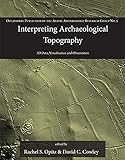Interpreting archaeological topography : airborne laser scanning, 3D data and ground observation / edited by Rachel S. Opitz and David C. Cowley.
Material type: TextSeries: Occasional publication of the Aerial Archaeology Research Group ; no. 5.Publisher: Oxford ; Oakville, CT : Oxbow Books, [2013]Description: ix, 268 pages : illustrations (chiefly color), maps (chiefly color), plans (some color) ; 29 cmContent type: text Media type: unmediated | unmediated | unmediated Carrier type: volume | volume | volumeISBN: 9781842175163 (hardback); 1842175165 (hardback)Subject(s): Archaeological surveying -- Laser use in | Topographical surveying -- Laser use in | Optical radar in archaeology | Three-dimensional imaging in archaeologyDDC classification: 930.1028 LOC classification: CC76.4 | .I67 2013
TextSeries: Occasional publication of the Aerial Archaeology Research Group ; no. 5.Publisher: Oxford ; Oakville, CT : Oxbow Books, [2013]Description: ix, 268 pages : illustrations (chiefly color), maps (chiefly color), plans (some color) ; 29 cmContent type: text Media type: unmediated | unmediated | unmediated Carrier type: volume | volume | volumeISBN: 9781842175163 (hardback); 1842175165 (hardback)Subject(s): Archaeological surveying -- Laser use in | Topographical surveying -- Laser use in | Optical radar in archaeology | Three-dimensional imaging in archaeologyDDC classification: 930.1028 LOC classification: CC76.4 | .I67 2013| Item type | Current library | Call number | Status | Date due | Barcode |
|---|---|---|---|---|---|
 Books
Books
|
The BIAA David H. French Library Shelf 38 - Main Room | G2c OPITZ 29500 | Not for loan | BOOKS-000000022448 |
Includes bibliographical references.
Interpreting archaeological topography : lasers, 3D data, observation, visualization and applications / Rachel S. Opitz and David C. Cowley -- An overview of airborne and terrestrial laser scanning in archaeology / Rachel S. Opitz -- Airborne laser scanning and archaeological interpretation : bringing back the people / Michael Doneus and Thomas Kühteiber -- Cultivating the 'wilderness' : how lidar can improve archaeological landscape understanding / Ole Risbøl -- I walked, I saw, I surveyed, but what did I see? ... and what did I survey? / Stratford Halliday -- Reading aerial images / Rog Palmer -- Messy landscapes : lidar and the practices of landscaping / Dimitrij Mlekuž -- Visualizations of lidar derived relief models / Žiga Kokalj, Klemen Zakšek and Krištof Oštir -- Worth a thousand words : photogrammetry for archaeological 3D surveying / Fabio Remondino --
From lidar to LSCM : micro-topographies of archaeological finds / Adrian A. Evans, Mhairi L. Maxwell and Gemma L. Cruickshanks -- Using lidar : drawing on 10 years's experience at English Heritage / Simon Crutchley -- Lidar and World Heritage Sites in Ireland : why was such a rich data source gathered, how is it being utilised, and what lessons have been learned? / Anthony Corns and Robert Shaw -- The role of lidar intensity data in interpreting environmental and cultural archaeological landscapes / Keith Challis and Andy J. Howard -- The changing picture of archaeological landscapes : lidar prospection over very large areas as part of a cultural heritage strategy / Ralf Hesse -- Lidar in Mediterranean agricultural landscapes : reassessing land use in the Mauguio / Nicolas Poirier, Rachel Opitz, Laure Nuninger, and Krištof Oštir --
Using lidar as part of a multi-sensor approach to archaeological survey and interpretation / Rebecca Bennett, Kate Welham, Ross A. Hill and Andrew Ford -- Remotely acquired, not remotely sensed : using lidar as a field survey tool / Stewart Ainsworth, Al Oswald and Dave Went -- Lidar survey in the Brú na Bóinne World Heritage Site / Stephen Davis, Conor Brady, William Megarry and Kevin Barton -- Immersive visualisation of survey and laser scanning : the case for using computer game engines / Keith Challis and Mark Kincey -- The practice of collaboration / Anthony Beck.
"Airborne Laser Scanning (ALS), or lidar, is an enormously important innovation for data collection and interpretation in archaeology. The application of archaeological 3D data deriving from sources including ALS, close-range photogrammetry and terrestrial and photogrammetric scanners has grown exponentially over the last decade. Such data present numerous possibilities and challenges, from ensuring that applications remain archaeologically relevant, to developing practices that integrate the manipulation and interrogation of complex digital datasets with the skills of archaeological observation and interpretation. This volume addresses the implications of multi-scaled topographic data for contemporary archaeological practice in a rapidly developing field, drawing on examples of ongoing projects and reflections on best practice. Twenty papers from across Europe explore the implications of these digital 3D datasets for the recording and interpretation of archaeological topography, whether at the landscape, site or artefact scale. The papers illustrate the variety of ways in which we engage with archaeological topography through 3D data, from discussions of its role in landscape archaeology, to issues of context and integration, and to the methodological challenges of processing, visualisation and manipulation. Critical reflection on developing practice and implications for cultural resource management and research contextualize the case studies and applications, illustrating the diverse and evolving roles played by multi-scalar topographic data in contemporary archaeology"--P. [4] of cover.
